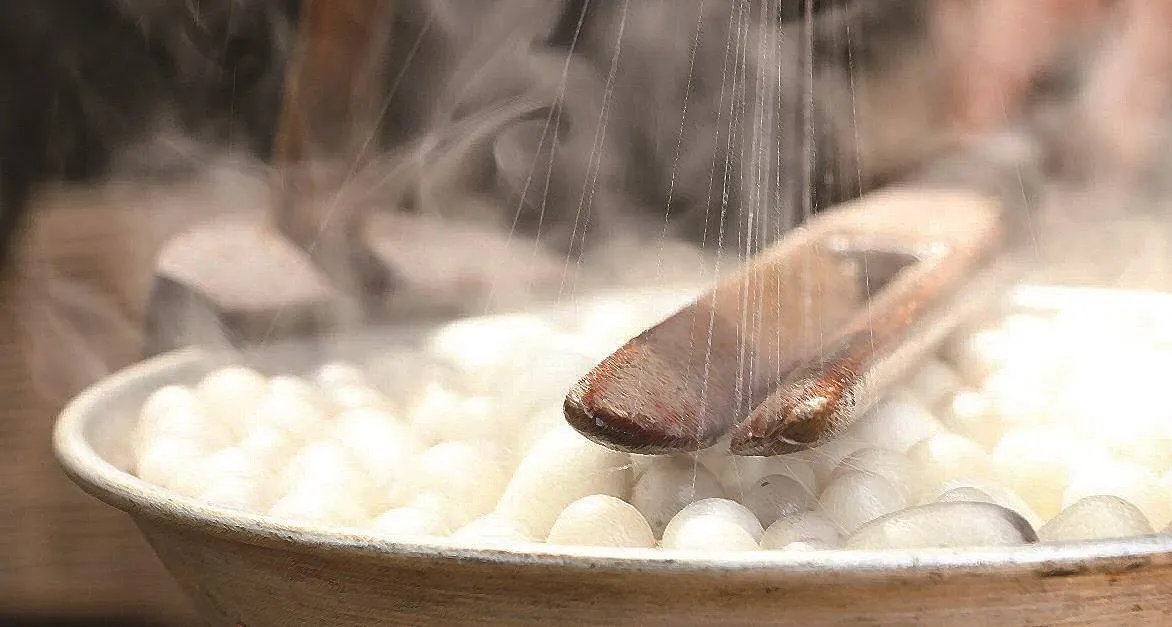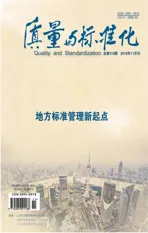中国文化的经典符号
2018-05-28五花肉
文/五花肉
丝绸是中国灿烂文化的经典符号,历经缫丝、织造、染整等工艺淬炼,以其卓越的品质、精美的花色和丰富的内涵名满天下,被誉为东方文明照亮世界的第一缕阳光。
Silk is a classic symbol of China's splendid culture. After silk reeling, weaving, dyeing and finishing, it is famous for its outstanding quality, exquisite color and rich connotation, and is praised as the first ray of sunshine for oriental civilization to illuminate the world.

缫丝重在水温
Water Temperature Control: Key Element of Reeling
“嫘祖栽蚕桑吐丝,抽丝织作绣神奇”,丝绸源于桑蚕,始于缫丝。缫丝,亦称抽丝,将蚕茧浸入水中反复以手振之,促其纾解为生丝。" Lei Zu raised silkworms and spun silk, reeling silk to make embroidery magic," silk originated from silkworms and started from silk reeling. Silk reeling,also known as silk reeling, involves repeatedly shaking silkworm cocoons in water to promote their release into raw silk.

在不同的水温下,蚕茧纾解的程度也不同。人们在长期实践中发现,当水温保持在80 ℃左右时,生丝的产出最佳,这一标准即使在现代丝绸生产工艺中依然被沿用。
Under different water temperatures, the degree of cocoon relief is also different. In long-term practice,it has been found that when the water temperature is kept at about 80 degrees Celsius, raw silk will produce the best. This standard is still used even in modern silk production technology.
织就绫罗缎锦
Weaving Satin and Brocade
“广裁衫袖长制裙,金斗熨波刀剪纹”,有了生丝原料,就可以进入下一道织造工艺。不同的织造工艺,造就了不同类型的丝绸制品,世人熟知的“绫罗绸缎、丝帛锦绢”就是其中的佼佼者。With raw silk raw materials, you can enter the next weaving process. Different weaving processes have created different types of silk products, among which"Satin and Brocade " is the best known in the world.
织造标准分平织和多重织两种。平织是最常见、最简单的单层编织,绫、绸都属于这一类,两者不同之处在于编织图案,前者以斜纹为标准,质地轻薄;后者则以平纹经纬交错为标准,挺括细密。多重织可视为不同类型的平织叠加,锦是其中的典型代表,以华丽花纹闻名,工艺复杂、价格昂贵,向有“织采为文,其价如金”之说。
Weaving standards are divided into two types: plain weave and multi-weave. Flat weave is the most common and simple single-layer weave. Twill and silk belong to this category. The difference between the two lies in the weave pattern. The former is based on twill and is light and thin. The latter is based on the standard of plain warp and weft interlacing and is crisp and fine. Multiple weaves can be regarded as the superposition of different types of flat weaves,among which brocade is the typical representative.It is famous for its gorgeous patterns, complex workmanship and high price, and it is said to have "weaves and picks as the text, and its price is as high as gold".
染整点睛之笔
Dyeing and Finishing:Finishing Point of Silk Art
完成了织造,丝绸原胚已基本成型,只欠最后的点睛之笔——染整,对半成品进行精炼、染色、整理,而染色则是其中决定性的核心工艺。
After finishing weaving, the silk embryo has been basically formed, and only the final finishing point,dyeing and finishing, is needed to refine. The semifinished products need dyeing and finishing, which are the decisive core technology.
古代丝绸染色原料多取自植物,煮水过滤制成染液,再将丝绸原胚浸入其中,成品的色度取决于浸染的时间和次数,初期只能依靠经验,差异性较大,直至唐代才有了统一标准。根据唐玄宗时期颁布的《唐六典》,“练染之作有六,一曰青、二曰绛、三曰黄、四曰白、五曰皂、六曰紫”,染整色度标准体系就此建立。
The dyeing materials of ancient silk were mostly taken from plants, boiled water was filtered to make dye liquor, and then silk embryos were immersed in the dye liquor. The chromaticity of the finished products depended on the time and times of impregnation.At the beginning, the dyeing materials depended on experience, and the difference was great, until the Tang Dynasty there was a unified standard. According to the " Six Classics of the Tang Dynasty" issued by Emperor Xuanzong of the Tang Dynasty, " there are six practices of dyeing and finishing, one is green,two is crimson, three is yellow, four is white, five is black, and six is purple." The dyeing and finishing chromaticity standard system has been established accordingly.
结 语
Conclusion
在标准化理念的引导下,丝绸织造从口口相传到代代传承,工艺日臻精益;承载着文化内涵和历史积淀,从中国走向世界,在传播东方文明的同时,也为世界人民贡献了更加精致的生活品质。Guided by the concept of standardization, silk weaving has been passed down from word of mouth to generation, and the process is getting leaner and leaner. Carrying the cultural connotation and historical accumulation, it moves from China to the world, spreading eastern civilization, and at the same time contributing more exquisite quality of life to the people of the world.
